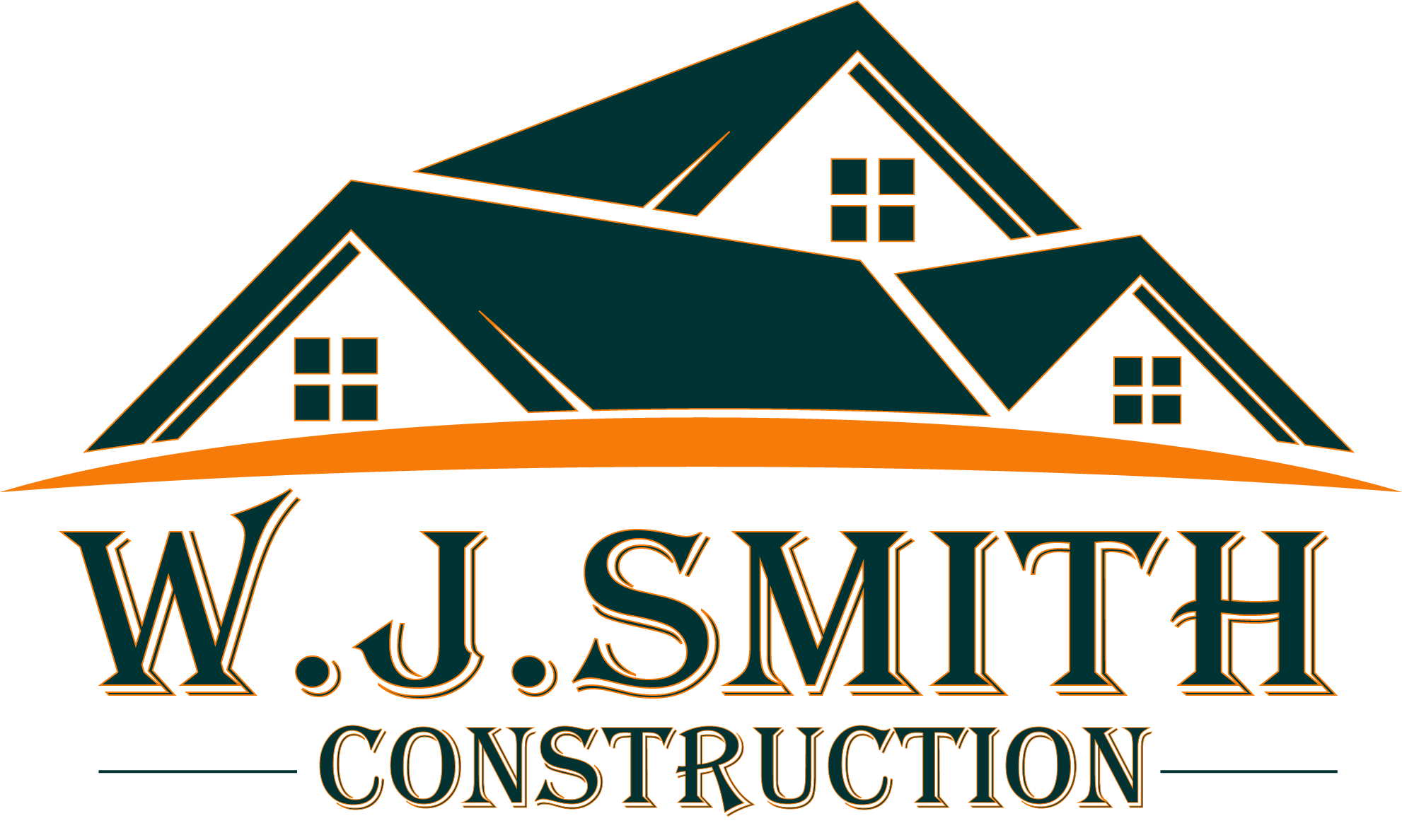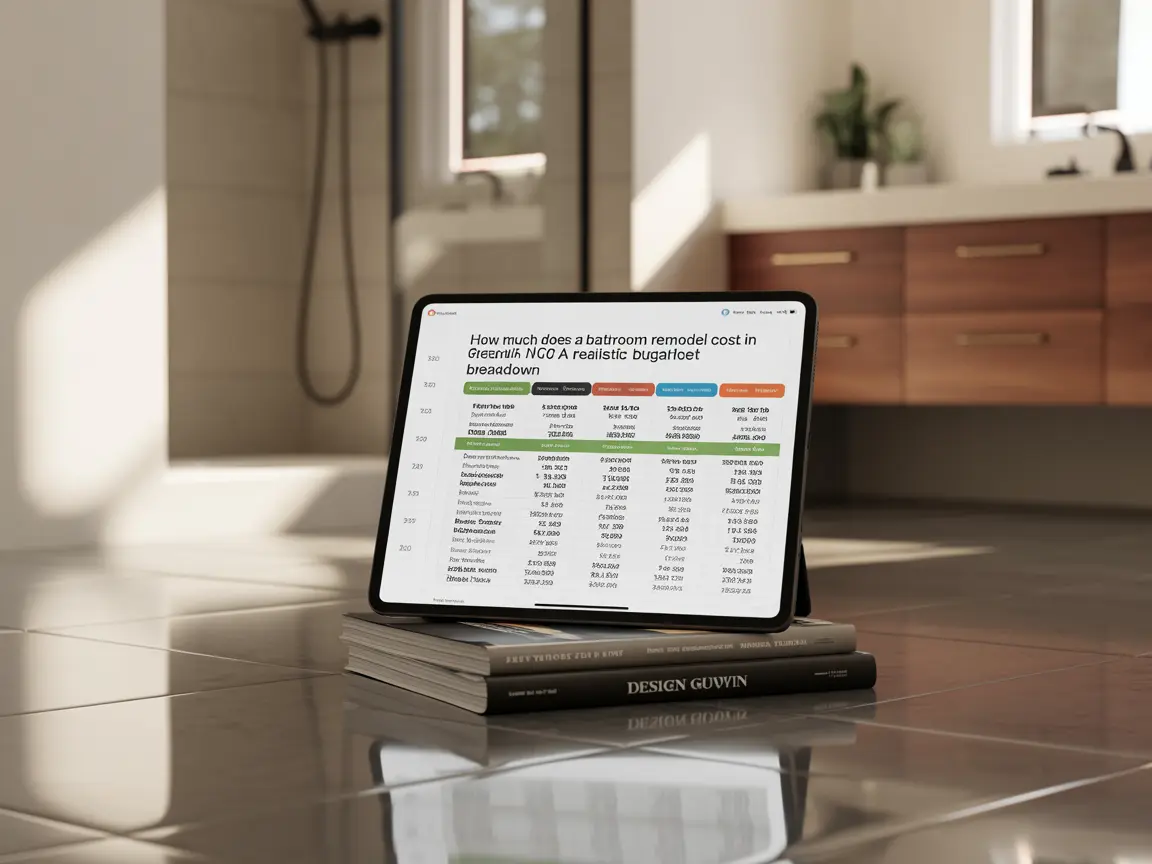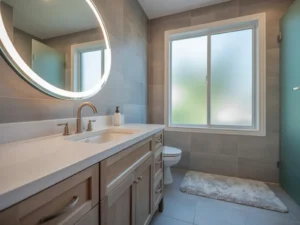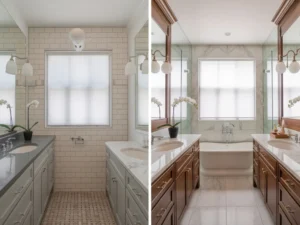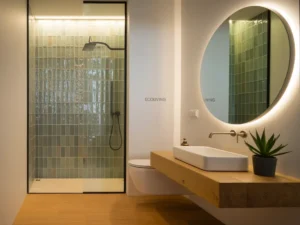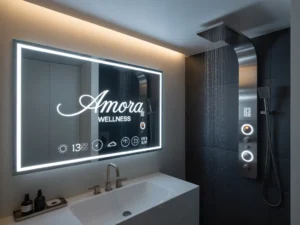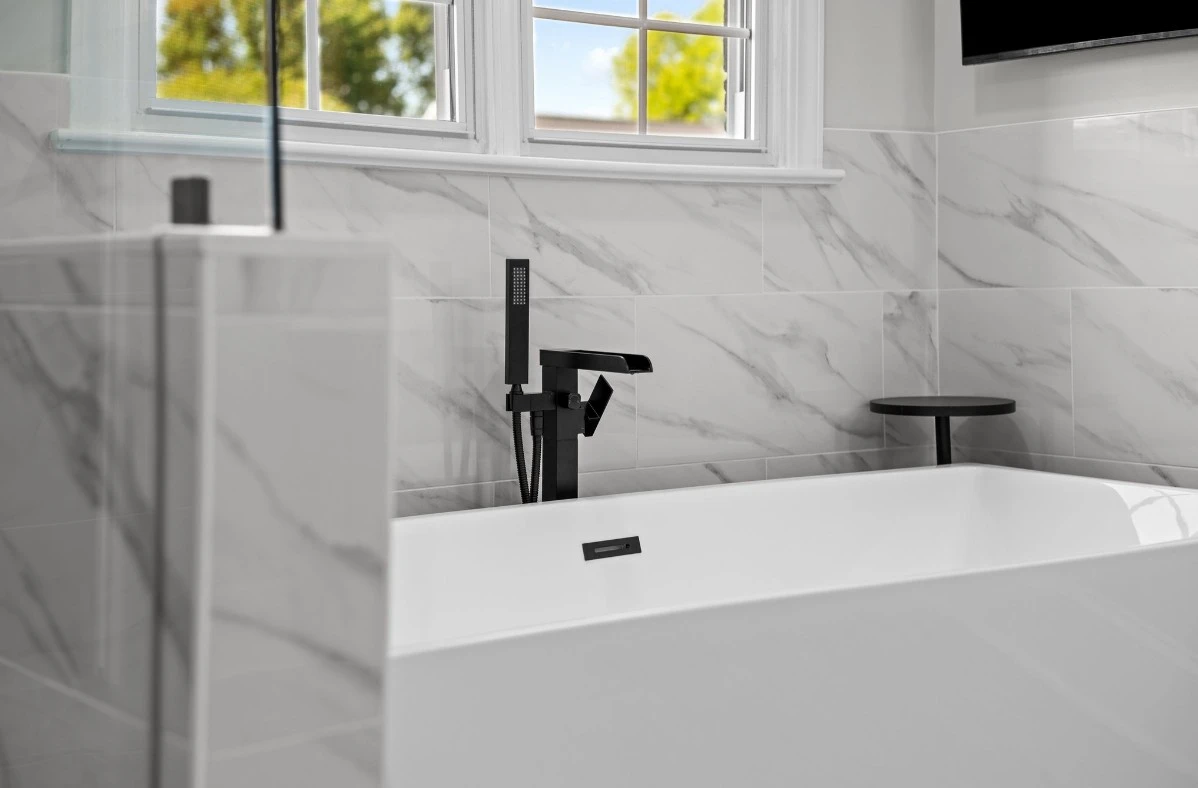Are you dreaming of transforming your bathroom into a spa-like retreat or updating an outdated space to increase your home’s value? A bathroom remodel is one of the most rewarding home improvement projects you can take on. But before you get too excited about the sleek tiles, luxurious bathtubs, or trendy fixtures you might want to install, it’s crucial to know exactly what you’re working with in terms of budget.
In Greenville, NC, the bathroom remodel scene has been steadily growing. With the rise of real estate demand in the area and homeowners looking to upgrade their spaces, remodeling projects are on the rise. Whether you’re considering a minor refresh or a complete overhaul, understanding the costs involved can help you avoid surprises and plan effectively.
But here’s the burning question: What’s the realistic budget for a bathroom remodel in Greenville, NC, in 2025?
In this blog post, we’ll break down the costs, offer smart strategies for staying within your budget, and show you how to make your bathroom remodel dreams a reality without breaking the bank. From the basics of choosing the right materials to hiring contractors, we’ll guide you through every step of the process. Plus, we’ll dive into current design trends and explain how they can influence your budget.
By the end of this post, you’ll have a solid understanding of how much you should expect to pay for your bathroom remodel in Greenville, NC, and, more importantly, how you can make sure you’re getting great value for your money.
Factors Affecting the Cost of a Bathroom Remodel
When it comes to remodeling your bathroom, understanding the key factors that influence the total cost is essential for creating a realistic budget. Whether you’re working with a small powder room or a large master bathroom, the decisions you make will impact your overall expenses. Here are the major factors that will play a role in how much you’ll pay for a bathroom remodel in Greenville, NC in 2025.
| Type of Remodel | Small Bathroom (Under 50 sq. ft.) | Medium Bathroom (50-100 sq. ft.) | Large Bathroom (Over 100 sq. ft.) |
|---|---|---|---|
| Minor Remodel (Under $10,000) | $5,000 – $7,000 | $7,000 – $9,000 | N/A |
| Mid-Range Remodel ($10,000 – $25,000) | $10,000 – $12,000 | $12,000 – $18,000 | $18,000 – $25,000 |
| Luxury Remodel ($25,000 and Above) | $25,000 – $30,000 | $30,000 – $40,000 | $40,000 – $60,000 |
1. Size of the Bathroom
The size of your bathroom will directly impact the cost of your remodel. Larger bathrooms require more materials, more labor, and generally more time to complete the project. Here’s how size can affect your costs:
-
Small Bathrooms: A small bathroom (less than 50 square feet) will be the least expensive to remodel. Expect costs in the range of $5,000 to $10,000 for a basic remodel, which includes new fixtures, fresh paint, and updated tiles.
-
Medium-Sized Bathrooms: A bathroom between 50 and 100 square feet will typically cost between $10,000 and $15,000 for a moderate remodel. This budget allows for more customization, such as replacing the shower or bathtub, installing new lighting, and upgrading plumbing.
-
Large Bathrooms: A larger space (over 100 square feet) requires a more substantial budget. The cost for a complete remodel in this case could range from $20,000 to $30,000, especially if you’re adding high-end features or reconfiguring the layout.
2. Scope of the Remodel
The scope of your bathroom remodel is another major factor in determining costs. Are you simply replacing outdated fixtures, or are you planning a complete overhaul? Here’s a look at how the scope affects pricing:
-
Cosmetic Updates: A simple update, like replacing a vanity, installing new fixtures, and adding fresh paint or new tile, can cost as little as $5,000 for a small bathroom. These types of updates offer a fresh look without requiring major construction work.
-
Partial Remodels: If you plan to replace the tub, shower, and tile work but leave the layout unchanged, your costs will likely range from $10,000 to $20,000 depending on the materials and labor involved.
-
Full Remodel: A full remodel, where you may reconfigure the layout, move plumbing, or update everything from the walls to the flooring, could cost anywhere from $15,000 to $30,000. Full remodels are typically the most expensive because they involve significant changes to both structure and aesthetics.
3. Materials and Finishes
Your choice of materials and finishes will play a major role in your total cost. You can opt for affordable, standard-grade materials or splurge on premium options. Here’s how the choice of materials affects cost:
-
Standard Materials: If you’re on a budget, you can choose standard ceramic or porcelain tiles, laminate countertops, and basic fixtures. This can bring your remodel costs down by as much as 30% compared to higher-end finishes.
-
Mid-Range Materials: For a more polished look, you might choose quartz countertops, subway tiles, or mid-tier fixtures. This option can cost 10-15% more than standard materials but offers a good balance of durability and aesthetics.
-
Luxury Materials: High-end materials such as marble countertops, custom cabinetry, luxury bathtubs, and designer faucets will push your costs higher. Luxury materials can increase your budget by 30% or more, and depending on the scope, they may even drive your remodel cost to $30,000 or higher.
4. Labor Costs in Greenville
Labor costs in Greenville can vary depending on the expertise and demand of contractors. On average, skilled contractors charge anywhere from $50 to $100 per hour, depending on their specialization. Here’s how labor costs break down:
-
General Contractors: For a mid-range remodel, you’ll likely need a general contractor to manage the project. Expect to pay around $60 to $80 per hour for their services.
-
Specialized Labor: If you need plumbing or electrical work done, specialized labor (like licensed plumbers or electricians) will cost more, averaging $75 to $100 per hour. For example, rerouting plumbing lines for a new shower or bathtub can significantly increase the cost of your remodel.
5. Unexpected Costs
No bathroom remodel is without surprises, especially when you start opening up walls or moving plumbing. Common unexpected costs can include:
-
Plumbing Issues: Older homes may have plumbing that isn’t up to code or has deteriorated over time. If you need to replace old pipes or rework the plumbing system, this could add $1,000 to $3,000 to your total cost.
-
Electrical Work: If you’re adding lighting, fans, or electrical outlets to meet modern needs, you may need to upgrade the electrical wiring. This could cost anywhere from $500 to $2,000 depending on the complexity of the project.
-
Water Damage or Mold Remediation: If you discover water damage or mold behind the walls, this will add additional costs. Remediation and repair could range from $1,000 to $4,000 or more, depending on the severity of the issue.
Average Costs for Different Types of Bathroom Remodels
When planning your bathroom remodel in Greenville, NC, it’s important to know the cost breakdown for different types of renovations. Whether you’re updating a few fixtures or going all out with a luxurious spa-like retreat, the costs can vary widely based on the scope of your project. Let’s dive into the average costs for different types of bathroom remodels in 2025, so you can make an informed decision based on your budget.
1. Minor Remodel (Under $10,000)
A minor remodel focuses on updating the essentials without making major structural changes. For homeowners looking to refresh their space on a budget, this option offers a significant transformation without breaking the bank.
What’s Included:
-
Replacing Fixtures: Installing a new vanity, sink, faucet, and toilet.
-
Updating Flooring: Replacing old, worn-out tiles or adding new vinyl or laminate flooring.
-
Fresh Paint and New Lighting: Adding a fresh coat of paint and swapping outdated light fixtures for modern options.
-
Minimal Plumbing Work: You may replace old faucets or install a new showerhead without requiring significant plumbing changes.
Cost Breakdown:
-
Small Bathroom: $5,000 to $7,000
-
Medium Bathroom: $7,000 to $9,000
-
Labor: $2,000 to $4,000 depending on the extent of the work
This type of remodel is perfect for homeowners who don’t need an extensive overhaul but still want a fresh, updated look.
2. Mid-Range Remodel ($10,000 – $25,000)
For homeowners who want more significant changes to their bathrooms—perhaps a new shower or bathtub, better tile work, and upgraded storage—this budget range is a great option. This remodel offers more customization, better materials, and higher-end fixtures without fully splurging on luxury finishes.
What’s Included:
-
Replacing Bathtub/Shower: Installing a new bathtub or replacing the shower unit. This may include re-tiling the surrounding area.
-
New Vanity and Countertops: Installing custom cabinetry or a modern vanity with high-quality stone countertops like granite or quartz.
-
Advanced Flooring: Luxury vinyl plank or porcelain tiles are popular choices for mid-range remodels.
-
Upgraded Plumbing and Fixtures: Replacing old plumbing with more efficient, high-end faucets, showerheads, and other fixtures.
Cost Breakdown:
-
Small Bathroom: $10,000 to $12,000
-
Medium Bathroom: $12,000 to $18,000
-
Large Bathroom: $18,000 to $25,000
-
Labor: $4,000 to $7,000 depending on complexity
A mid-range remodel allows you to invest in both aesthetics and functionality, increasing the comfort and value of your bathroom without going overboard.
3. Luxury Remodel ($25,000 and Above)
A luxury remodel is perfect for homeowners who want to transform their bathroom into a luxurious, spa-like retreat. If you’re after high-end finishes, custom cabinetry, designer fixtures, and perhaps even smart technology, this is the route to take.
What’s Included:
-
Custom Design and Layout: Changing the layout entirely to add features like a walk-in shower, soaking tub, or double vanity.
-
High-End Materials: Marble countertops, custom cabinetry, and premium tiles such as large-format porcelain or even mosaic tiling.
-
Smart Technology: Adding features like a smart mirror, heated floors, advanced shower systems, or even a digital toilet.
-
Spa-Like Features: Installing a luxury bathtub, rainfall shower, or incorporating an advanced ventilation system.
Cost Breakdown:
-
Small Bathroom: $25,000 to $30,000
-
Medium Bathroom: $30,000 to $40,000
-
Large Bathroom: $40,000 to $60,000 (or more)
-
Labor: $8,000 to $15,000, especially with specialized contractors or high-end finishes
A luxury remodel will significantly increase the value of your home and provide you with a space that feels like a private sanctuary. However, it’s important to note that while this is the most expensive option, it’s also the most rewarding for those seeking a high-end bathroom experience.
4. Cost per Square Foot
To better understand the costs involved in your bathroom remodel, consider the cost per square foot. This gives you a way to estimate the price based on the size of your bathroom, and it can be useful for comparing different remodel scenarios.
-
Standard Remodel: The average cost per square foot in Greenville is around $150 to $200 for a standard bathroom remodel, which includes basic updates such as new fixtures, flooring, and painting.
-
High-End Remodel: If you’re opting for luxury materials or custom designs, you can expect the price to rise to about $250 to $350 per square foot or even more for larger spaces.
This cost per square foot can help you determine how much you’ll need based on the size of your bathroom, so you can adjust your expectations accordingly.
5. Greenville-Specific Cost Trends
Greenville, NC, is a mid-sized city with a relatively affordable cost of living compared to larger cities, but the demand for home renovations has increased in recent years, particularly in the housing market. As a result, remodeling costs have risen slightly in 2025. Here’s how Greenville compares:
-
National Average: The average bathroom remodel cost in the U.S. in 2025 is around $15,000 to $25,000 for a mid-range remodel.
-
Greenville’s Local Trends: While Greenville’s costs tend to be lower than the national average, the increasing popularity of home renovations has pushed prices up by about 5-10% in the last few years. Expect to pay about 10% less than what you would in larger metropolitan areas like Raleigh or Charlotte for similar remodels.
Greenville homeowners can still get great value with competitive pricing, especially if they choose local contractors who understand the specific needs of the area.
Popular Bathroom Trends in 2025 and Their Impact on Your Budget
When remodeling your bathroom, the latest trends can help you turn an outdated space into a luxurious, functional oasis. However, as with any design trends, these modern updates can come at a cost. In 2025, bathroom designs are all about combining functionality with aesthetics, and these trends will impact your remodeling budget in varying degrees. Let’s explore the most popular bathroom trends this year and how they can influence your costs.
| Feature | Cost Range (Standard) | Cost Range (Mid-Range) | Cost Range (Luxury) |
|---|---|---|---|
| Flooring | $3 – $10 per sq. ft. | $10 – $15 per sq. ft. | $20+ per sq. ft. |
| Countertops | $30 – $80 per sq. ft. | $80 – $150 per sq. ft. | $200+ per sq. ft. |
| Bathtub/Shower | $300 – $1,500 | $1,500 – $5,000 | $5,000+ |
| Smart Fixtures | N/A | $500 – $2,000 | $2,000+ |
| Vanities and Cabinets | $300 – $1,500 | $1,500 – $5,000 | $5,000+ |
1. Sustainable Materials
Eco-conscious homeowners are increasingly opting for sustainable materials that are not only better for the environment but also help reduce energy costs. Sustainable bathroom design involves using natural materials, water-saving fixtures, and energy-efficient lighting. While these choices are beneficial in the long run, they can sometimes come with a higher upfront cost.
Popular Sustainable Materials:
-
Recycled Glass Tiles: These tiles can add a unique, stylish touch to your bathroom while being environmentally friendly. However, they are typically more expensive than standard ceramic tiles.
-
Bamboo Flooring: A sustainable alternative to hardwood, bamboo is durable and looks modern. It’s also water-resistant, making it a great choice for bathrooms.
-
Low-Flow Fixtures: Water-saving toilets, faucets, and showerheads can significantly reduce water bills, though they often cost more upfront than traditional models.
Cost Impact: Expect to pay anywhere from 10-20% more for sustainable materials. For example, recycled glass tiles can cost $15 to $30 per square foot, compared to $5 to $15 for standard ceramic tiles.
2. Smart Bathroom Technology
Smart technology is making its way into the bathroom, enhancing comfort and convenience. Smart showers, mirrors, and lighting systems are becoming common features in modern remodels. However, adding these features will raise your costs significantly, so it’s important to weigh the benefits against the additional price.
Popular Smart Features:
-
Smart Showers: These showers come with temperature controls, water flow customization, and even features like music or lighting integration. Expect to pay anywhere from $1,000 to $5,000 for a fully integrated smart shower system.
-
Smart Mirrors: Mirrors that display time, weather, or allow you to control lighting and defogging. These typically cost $500 to $1,500.
-
Smart Lighting: LED lights that adjust automatically to time of day or user preferences. Adding smart lighting can cost an additional $200 to $800 for installation.
Cost Impact: Smart technology can increase your bathroom remodel by $2,000 to $7,000, depending on the features you choose. For a luxury remodel with smart tech, the price could easily exceed $40,000.
3. Spa-Like Features
The trend of turning your bathroom into a spa-like retreat continues to grow in 2025. Features like rainfall showers, soaking tubs, and heated floors are sought after for their luxury feel and relaxing ambiance. These high-end features can dramatically improve your bathroom’s functionality and design but come with a premium price tag.
Popular Spa Features:
-
Rainfall Showers: These provide a luxurious and relaxing experience. Installing a rainfall showerhead can cost anywhere from $300 to $1,500, depending on the complexity of the setup.
-
Soaking Tubs: Freestanding tubs and deep soaking bathtubs are popular choices for a spa-like atmosphere. Expect to pay between $1,500 and $5,000 for a high-quality soaking tub.
-
Heated Floors: Radiant floor heating adds comfort and luxury, especially in cold weather. This can add $1,500 to $3,000 to your remodel.
Cost Impact: Adding spa-like features can increase your remodel costs by $3,000 to $10,000. The higher the quality and the more extensive the features, the more you can expect to pay.
4. Minimalist Designs
Minimalism is trending in bathroom design for 2025. Clean lines, open shelving, and simple designs allow the bathroom to feel spacious, calming, and organized. While minimalist design can often be less expensive due to fewer materials, achieving a streamlined, modern look can still require some investment.
Minimalist Design Features:
-
Floating Vanities: These vanities create the illusion of more space by being mounted on the wall, leaving the floor open. They typically cost $1,500 to $3,000, depending on the material and design.
-
Open Shelving: Open shelving systems for storage are popular, but they may require more careful planning and custom cabinetry to keep the space functional. Expect costs in the range of $500 to $2,500.
-
Neutral Color Schemes: While neutral tones such as whites, grays, and beiges are timeless, using high-quality paints and finishes to create a minimalist aesthetic can be slightly more expensive than typical color schemes.
Cost Impact: Minimalist design can help save on materials, but the need for custom pieces, high-end finishes, and careful planning might result in a remodeling cost that’s comparable to mid-range or even luxury remodels, ranging from $10,000 to $20,000.
5. Greenville’s Aesthetic Preferences
In Greenville, NC, bathrooms are increasingly reflecting regional preferences that blend modern convenience with traditional Southern charm. This includes adding rustic or farmhouse-style elements with high-end finishes, as well as creating a more serene, spa-like atmosphere. Homeowners are often seeking a balance between luxury and comfort, incorporating materials like wood-look tiles, natural stone, and vintage-inspired fixtures.
Bathroom Remodel Cost Comparison by Square Foot
Greenville Bathroom Trends:
-
Farmhouse and Vintage Style: The combination of traditional Southern charm with modern luxuries remains a popular aesthetic in Greenville. For instance, adding vintage-style faucets, barn doors, or distressed wood accents can provide a unique flair while maintaining functionality.
-
Natural Stone Accents: Many homeowners are opting for natural stone such as slate or marble to enhance the look of their bathrooms. However, natural stone can be costly—expect to pay $10 to $50 per square foot for quality options.
-
Customized Storage Solutions: Many remodels in Greenville include custom storage built to maximize space, such as built-in shelving and cabinetry. This can add anywhere from $2,000 to $5,000 to your budget.
Cost Impact: Adding customized, locally inspired features to your bathroom remodel will increase the overall price, but this can be a wise investment for creating a space that aligns with regional tastes. Costs for these features can add anywhere from $2,000 to $10,000, depending on the complexity.
Tips to Stay Within Budget While Maximizing Value
Remodeling a bathroom is an exciting but expensive project. While it’s tempting to splurge on the latest fixtures and finishes, staying within your budget while maximizing the value of your remodel is possible with the right strategy. In this chapter, we’ll offer practical tips on how to get the most out of your budget, avoid overspending, and still create a beautiful and functional bathroom.
1. Prioritize Needs Over Wants
One of the easiest ways to stay within budget is to focus on the essentials before considering luxury upgrades. When planning your remodel, ask yourself: “What does my bathroom really need?”
What to Prioritize:
-
Functionality: If your current layout doesn’t work well or if you have outdated plumbing, these should be your top priorities. Fixing functionality issues can add value and convenience, which is worth the investment.
-
Essential Fixtures: New faucets, sinks, toilets, and a fresh coat of paint can dramatically improve your space without needing to go all-out on luxury features like heated floors or a custom-built shower.
-
Durable Materials: Opt for materials that are durable but don’t necessarily have to be top-of-the-line. For example, porcelain tiles look elegant and are highly durable, without the hefty price tag of marble.
Cost Impact: By focusing on your bathroom’s core needs, you can save money on high-end finishes that may not add much in terms of everyday functionality.
2. DIY vs. Hiring Professionals
A remodel doesn’t always require hiring professionals for every single task. Understanding when it’s wise to take on a DIY project can save you a considerable amount of money.
DIY Tasks You Can Tackle:
-
Painting: Giving your bathroom a fresh coat of paint is an easy, affordable way to refresh the space.
-
Installing New Fixtures: Replacing faucets, showerheads, or light fixtures can be a manageable task if you have basic DIY skills.
-
Tile Work: If you’re comfortable with the process, laying tile on the floor or walls can be a rewarding and cost-effective DIY job.
When to Hire a Professional:
-
Plumbing and Electrical Work: These tasks require skilled professionals to avoid safety hazards and ensure everything is up to code.
-
Complex Installations: Installing custom vanities or relocating plumbing and electrical systems is best left to the experts.
Cost Impact: Doing smaller projects yourself can save you thousands. However, for anything that involves plumbing, electrical, or structural changes, hiring a professional ensures a job well done and helps avoid costly mistakes.
3. Buy Materials in Bulk
Purchasing materials in bulk is a great way to save money, especially for items like tile, paint, or flooring. Many local home improvement stores offer discounts for bulk orders, so it’s worth asking about any available deals.
What to Buy in Bulk:
-
Tile and Flooring: If you’re tiling the floor and walls, buying extra tile ensures you have enough for the job while also saving money. You can often return any unused materials.
-
Fixtures and Hardware: Buying in bulk for items like faucets, showerheads, and cabinet hardware can help you save on individual costs.
Tip: If you’re working with a contractor, ask them to source the materials for you at wholesale prices. Often, contractors have relationships with suppliers that allow them to get discounted rates on bulk orders.
Cost Impact: Purchasing in bulk can reduce the cost of materials by 10-20%, and returning any excess items means you won’t end up wasting money.
4. Repurpose Existing Fixtures
Instead of replacing everything in your bathroom, consider repurposing or restoring existing fixtures to save money. For example:
-
Refinish the Tub: If your bathtub is in good condition but looks outdated, refinishing it instead of replacing it can save you up to $1,000.
-
Update Cabinets: Instead of installing entirely new cabinetry, consider painting or re-staining your existing cabinets. Adding new hardware can also give them a fresh look.
-
Retile Instead of Full Replacement: If your bathroom tiles are in good condition but have worn grout or discoloration, consider regrouting or cleaning the existing tiles rather than replacing them entirely.
Cost Impact: Repurposing or refinishing old fixtures can save you hundreds, if not thousands, depending on the scope of the work.
5. Don’t Overbuild for the Neighborhood
One common mistake homeowners make is overinvesting in a remodel by adding luxury features that are out of sync with the surrounding homes. While upgrading your bathroom is great for resale value, you don’t want to overspend on high-end finishes that won’t provide a good return on investment.
What to Consider:
-
Home Value: Research the average home value in your neighborhood. If your home is in a lower price range, a high-end bathroom remodel may not significantly increase the value of your property.
-
Matching Local Trends: Keep in mind that homebuyers in Greenville, NC, may not expect top-of-the-line features like smart mirrors or custom tubs in mid-range homes. Stick to the trends and finishes that fit your neighborhood’s market.
Cost Impact: Spending too much on your bathroom remodel can lead to a situation where you have a bathroom that’s far more expensive than the value it adds to your home. By keeping your remodel in line with local trends and home values, you’ll ensure that you’re getting the best return on investment.
| Type of Remodel | Estimated Duration |
|---|---|
| Minor Remodel | 1 – 2 Weeks |
| Mid-Range Remodel | 3 – 6 Weeks |
| Luxury Remodel | 6 – 8 Weeks or More |
Finding the Right Contractor for Your Bathroom Remodel
One of the most important aspects of a successful bathroom remodel is finding the right contractor. Hiring a reputable professional can save you both time and money while ensuring your project meets your expectations. But how do you find the perfect contractor for your bathroom remodel in Greenville, NC? In this chapter, we’ll walk you through the essential steps to ensure you choose the right contractor for the job and avoid costly mistakes.
1. How to Get Accurate Estimates
Before committing to a contractor, it’s important to obtain accurate and detailed estimates. This helps you gauge the project’s cost and allows you to compare different contractors’ offers.
How to Get a Reliable Estimate:
-
Request Multiple Quotes: Don’t settle for the first estimate you receive. Contact at least three contractors to get a sense of the market rate for your remodel.
-
Be Specific About Your Needs: Clearly outline your vision and the work you want to be done. Provide as much detail as possible to avoid discrepancies later on.
-
Include Everything in the Estimate: Ensure that the estimate covers all costs, including labor, materials, permits, and any unforeseen expenses (such as plumbing or electrical work). A well-detailed estimate helps prevent hidden costs down the line.
Cost Impact: Taking the time to request accurate, detailed estimates ensures that you have a realistic view of your remodel’s costs and prevents overpaying or underbudgeting for the project.
2. Choosing a Local Contractor in Greenville
Hiring a local contractor in Greenville, NC, offers several benefits. Local contractors understand the area’s building codes, have established relationships with suppliers, and are familiar with regional design trends. They are also more likely to be invested in their reputation within the community.
Why Choose a Local Contractor:
-
Knowledge of Local Regulations: Local contractors will ensure your remodel complies with Greenville’s building codes and regulations, which can help you avoid fines or delays.
-
Familiarity with Local Trends: A contractor familiar with local styles and preferences can help you design a bathroom that appeals to the Greenville market, especially if you plan to sell your home in the future.
-
Easier Communication: Working with a contractor in your area means it’s easier to schedule meetings, make changes, and resolve issues quickly.
Cost Impact: While hiring a local contractor may not always be the cheapest option, you’ll save money in the long run by avoiding delays or costly mistakes due to lack of knowledge about local codes and trends.
3. Ensuring Transparency
One of the keys to a successful remodel is open communication with your contractor. You need to feel confident that your contractor is being upfront with you about costs, timelines, and any issues that arise.
What to Look for in a Transparent Contractor:
-
Clear Contract Terms: Make sure that all the details, including cost breakdowns, timelines, payment schedules, and warranty information, are clearly outlined in the contract.
-
Communication: A good contractor will keep you informed about the progress of your remodel. If issues arise, they should promptly address them and discuss the best course of action.
-
Change Orders: Changes to the project, whether minor or major, should be documented in writing. This helps you avoid additional costs that weren’t initially planned for.
Cost Impact: Ensuring transparency will help you stay within budget and avoid unexpected costs. You’ll also have a clearer understanding of the timeline and the scope of work being performed, preventing costly misunderstandings.
4. Contracts and Agreements
Before work begins, make sure that you have a signed contract with your contractor. A well-drafted contract protects both you and the contractor and sets expectations for the entire project.
What Should Be in Your Contract:
-
Scope of Work: This should outline the specific tasks the contractor will perform, as well as the materials and finishes that will be used.
-
Payment Schedule: Set clear terms for when payments are due, whether it’s based on project milestones or a fixed percentage upfront.
-
Timeline: The contract should include a timeline for completion, with specific deadlines for each phase of the remodel.
-
Liability Insurance and Licenses: Make sure the contractor carries the proper insurance and is licensed to work in your area. This protects you in case of accidents or damage during the remodel.
Cost Impact: Having a solid contract in place helps ensure that the project is completed on time and within budget, without the risk of hidden costs or work that is outside the original scope.
5. Reputation and Reviews
Hiring a reputable contractor is one of the best ways to ensure a smooth remodel. Do your research by checking reviews, asking for references, and reviewing their previous work.
How to Check a Contractor’s Reputation:
-
Online Reviews: Check platforms like Google, Yelp, and Angie’s List for customer feedback. Look for contractors with consistently positive reviews and take note of any complaints.
-
Ask for References: A trustworthy contractor should be able to provide references from previous clients. Reach out to these homeowners to learn about their experience.
-
Visit Past Projects: If possible, visit a current job site or view before-and-after photos of completed remodels to evaluate the quality of the contractor’s work.
Cost Impact: A contractor with a strong reputation will help avoid the risk of poor-quality work or unethical business practices. Investing a little extra time in researching contractors will ultimately save you money by ensuring you hire someone who does the job right the first time.
FAQ Section: Common Questions About Bathroom Remodels in Greenville, NC
To wrap up our guide, let’s address some frequently asked questions that can help clarify any remaining doubts and provide extra insights for your bathroom remodel project in Greenville, NC.
1. How long will a bathroom remodel take in Greenville, NC?
The duration of your bathroom remodel can vary depending on the scope of the project. A minor remodel, such as replacing fixtures or refreshing the paint, can take as little as 1 to 2 weeks. However, for more involved projects, like full remodels or reconfiguring layouts, expect it to take anywhere from 4 to 8 weeks.
Factors that affect timing:
-
Size of the bathroom: Larger bathrooms will take more time to complete.
-
Scope of the remodel: The more extensive the work, the longer the process.
-
Materials availability: Special order materials or high-end finishes may delay the process.
-
Contractor availability: Scheduling conflicts or delays from the contractor can also extend the timeline.
2. Can I remodel my bathroom on a budget without compromising quality?
Absolutely! With careful planning and smart decisions, it’s possible to remodel your bathroom on a budget while still achieving a high-quality result. Here are some tips to help:
-
Focus on cosmetic updates like painting, swapping out fixtures, and upgrading flooring.
-
Opt for mid-range materials like porcelain or ceramic tiles, which provide great durability at a fraction of the cost of premium materials.
-
Do some DIY work where possible—painting, installing new hardware, and minor repairs can all be done by yourself to save money.
By being mindful of the materials and the scope of the work, you can create a stylish bathroom without breaking the bank.
3. What are the most expensive elements of a bathroom remodel?
The most expensive aspects of a bathroom remodel tend to be:
-
Labor costs: Hiring skilled professionals like plumbers, electricians, and general contractors can account for a significant portion of your budget.
-
High-end materials: Premium materials like marble, custom cabinetry, or designer fixtures can add a lot to your overall costs.
-
Reconfiguration: Moving plumbing lines, electrical wiring, or changing the layout of the space adds time and complexity, which increases costs.
Focusing on less expensive materials and limiting structural changes can keep these costs down.
4. How do I know if I need a permit for my bathroom remodel in Greenville?
In Greenville, NC, a permit is typically required for any remodels that involve changing the plumbing, electrical systems, or layout. For cosmetic updates like replacing a vanity or swapping out tiles, you may not need a permit. However, it’s always best to check with your contractor and the local building department to ensure compliance with any regulations.
Common remodels requiring permits:
-
Moving plumbing or electrical work
-
Installing or relocating a toilet, shower, or bathtub
-
Adding or changing windows or doors
-
Altering the layout of the bathroom
By obtaining the necessary permits, you’ll ensure that your remodel meets local building codes and avoid fines or delays.
5. Are there any financing options for bathroom remodels in Greenville?
Yes, many homeowners in Greenville use various financing options for bathroom remodels. Some contractors offer payment plans or financing directly through their companies. Additionally, there are several third-party lenders and banks that provide home improvement loans.
Popular financing options include:
-
Personal loans: Unsecured loans that can be used for home improvements.
-
Home equity loans or lines of credit (HELOC): These options allow you to borrow against the equity in your home.
-
Credit cards: If the remodel is small, using a credit card with 0% interest for an introductory period could be an option.
It’s important to compare interest rates, terms, and repayment plans before selecting the best option for your situation.
Conclusion: Your Path to a Successful Bathroom Remodel in Greenville, NC
Undertaking a bathroom remodel in 2025 can be both an exciting and daunting task. With proper planning, a realistic budget, and a clear vision of what you want to achieve, your remodel can significantly enhance both the functionality and value of your home. Whether you’re looking to refresh a few details or completely transform your space into a luxury retreat, knowing the costs, trends, and tips we’ve shared will help guide you every step of the way.
Remember to prioritize your needs, choose the right materials, and hire a trustworthy contractor who understands your vision. By focusing on quality over quantity and staying within your budget, you can create a bathroom that’s both beautiful and functional.
Now, armed with all the knowledge you need about realistic budgets, popular trends, and cost-saving strategies, you’re ready to turn your bathroom remodel dreams into a reality. Happy remodeling!
